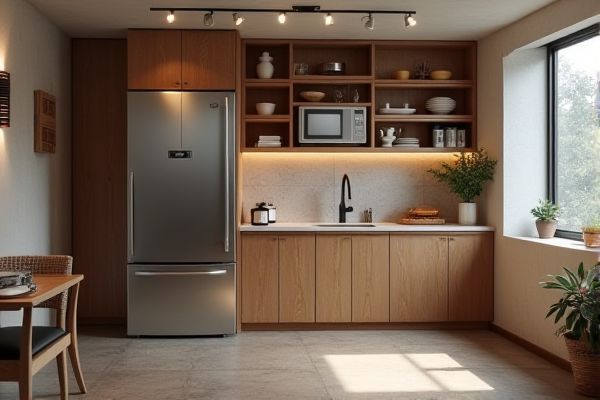
Minifridges offer compact, energy-efficient cooling ideal for small spaces, while beverage centers provide temperature-controlled shelves designed specifically for drink storage. Discover which option best suits Your needs by exploring the full comparison in the rest of the article.
Table of Comparison
| Feature | Minifridge | Beverage Center Basement |
|---|---|---|
| Primary Use | General food and beverage storage | Dedicated beverage storage and chilling |
| Temperature Range | Typically 34degF to 40degF (1degC to 4degC) | Optimized for 38degF to 50degF (3degC to 10degC) |
| Storage Capacity | Small to medium, around 1.7 to 4.5 cubic feet | Varies, often spacious for bottles and cans |
| Shelving | Adjustable shelves for mixed items | Specialized racks for cans and bottles |
| Energy Efficiency | Moderate energy consumption | Often designed to be energy efficient |
| Design & Appearance | Compact, versatile for dorms/offices | Sleek, often glass door for display |
| Ideal Location | Bedrooms, offices, small kitchens | Basement bars, entertainment rooms |
Introduction: Minifridge vs Beverage Center for Basements
Minifridges offer compact cooling solutions with versatile storage options suitable for tight basement spaces, emphasizing efficient use of limited square footage. Beverage centers are specifically designed to store drinks, featuring temperature zones optimized for bottles and cans, often including adjustable shelves for organized beverage display. Choosing between a minifridge and a beverage center depends on the user's need for general food storage versus specialized drink chilling in basement environments.
Understanding the Purpose: Minifridge and Beverage Center
Minifridges are designed primarily for compact, versatile food and drink storage, offering customizable temperature settings to accommodate both perishables and beverages. Beverage centers focus on optimizing drink storage with specialized shelving and consistent cooling that preserves carbonation and flavor. Choosing between a minifridge and a beverage center depends on your specific needs for versatile storage or dedicated beverage preservation in your basement space.
Space and Capacity Comparison
A minifridge typically offers compact storage with capacities ranging from 1.7 to 4.5 cubic feet, making it ideal for small spaces and limited beverage needs. Beverage centers often provide larger capacities between 4.5 to 24 cubic feet with adjustable shelves designed specifically for cans, bottles, and wine storage. The basement installation usually favors beverage centers for extensive storage, while minifridges excel in maximizing minimal space with efficient cooling compartments.
Temperature Control and Consistency
Minifridges typically offer basic temperature control settings, which may result in fluctuations affecting the consistency of your stored items. Beverage centers often feature advanced temperature zones designed to maintain stable and precise cooling, ideal for preserving drinks at optimal temperatures. Your choice depends on whether you prioritize versatility or consistent temperature performance for your basement storage needs.
Versatility of Storage Options
Mini fridges offer versatile storage with adjustable shelves and compartments designed for cans, bottles, and snacks, making them ideal for compact spaces. Beverage centers prioritize display and easy access with dedicated bottle racks and adjustable temperature zones tailored specifically for drinks. Both options maximize basement storage efficiency, but mini fridges provide greater flexibility for mixed food and beverage storage needs.
Energy Efficiency and Operating Costs
Minifridges typically consume more energy per cubic foot compared to beverage centers designed for basement use, as beverage centers often incorporate advanced insulation and temperature control tailored for frequent cooling cycles. Operating costs for a minifridge may be higher due to its smaller compressor running more frequently, while beverage centers with energy-efficient compressors and ENERGY STAR ratings minimize electricity consumption. Selecting a beverage center with precise temperature zones reduces energy waste and lowers utility bills over time, making it a cost-effective option for basement environments.
Noise Levels and Basement Placement
Minifridges typically produce low, consistent noise levels due to their compact compressors, making them suitable for basement use without causing significant disturbance. Beverage centers often have variable noise output depending on size and cooling method, which might be more noticeable in quiet basement environments. Your choice should consider the specific noise tolerance in your basement and whether the appliance's placement allows for adequate ventilation to maintain efficient operation.
Design and Aesthetic Fit for Basements
Minifridges typically have compact, utilitarian designs suited for tight spaces, but they may lack the sleek appearance desired in a finished basement. Beverage centers offer a more refined, stylish aesthetic with glass doors and modern finishes that blend seamlessly into basement bars or entertainment areas. Choosing a beverage center can elevate Your basement's design by providing both functionality and a polished look.
Maintenance and Durability Considerations
Minifridges typically require regular defrosting and cleaning to prevent mold and odor buildup, while beverage centers often feature auto-defrost systems that reduce maintenance efforts. Durability varies by brand and build quality, but beverage centers are usually designed with commercial-grade components to withstand frequent use and temperature changes. You should consider your usage habits and space conditions to choose between low-maintenance operation and long-lasting reliability.
Making the Best Choice: Minifridge or Beverage Center for Your Basement
Choosing between a minifridge and a beverage center for your basement depends on your storage needs and space constraints. A minifridge offers versatile cooling for snacks and drinks with compact design, while a beverage center provides specialized temperature zones and stylish visibility for bottles and cans. Consider Your preference for temperature control and capacity to ensure you make the best choice for convenient basement refreshment.
 homyna.com
homyna.com